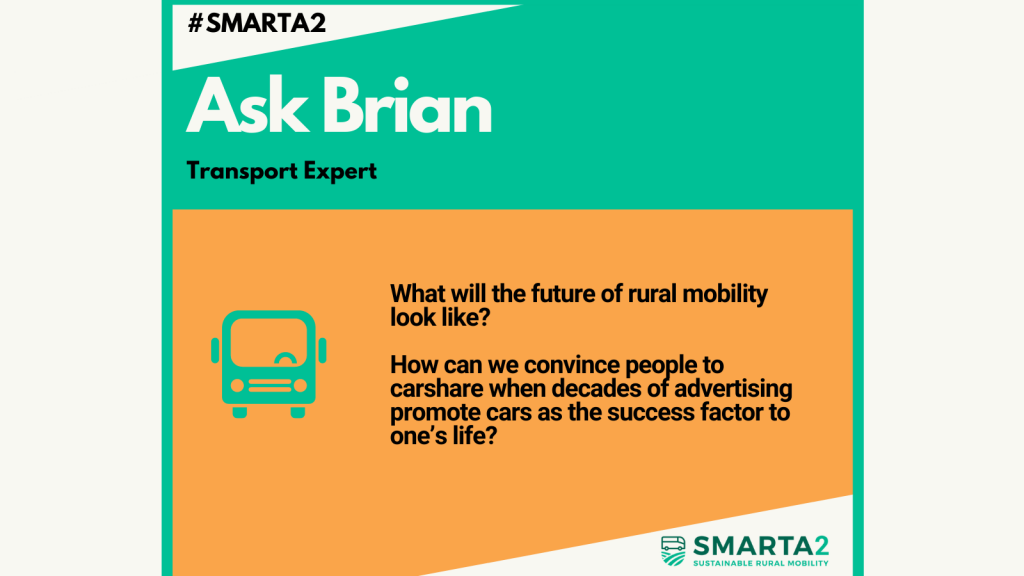
Ask Brian: What will the future of rural mobility look like?

Ηow can we convince people to carshare when decades of advertising promote cars as the success factor to one’s life?
It is true, everything comes back to this image. The motor industry has spent decades and vast amounts of money on advertising: you can see cars everywhere including cinemas, newspapers, TV. Success at all stages of life depends on the car we use. Or so it would appear. However, the reality is somewhat different. More cars, more cars, more cars. The result is congestion, poor air quality, environmental, social, and health impacts. In comparison, Public Transport organisations do not spend anything like the automotive industry to convince us to use alternatives to car ownership. What we needed was a crisis to make people wake up to the issues. Climate change and the COVID-19 pandemic are providing the catalyst for change. These challenges have offered us the opportunity to put things into perspective. What do we want the post-Covid world to look like?  Months of isolation reliant on home deliveries and being cut off from daily routines are resulting in the reappraisal of what is important in life.  Communities are coming together to help each other get through this crisis. Can we build on this coming together to create long-lasting sustainable communities?  People after the pandemic are likely to be more willing to break down trust-barriers and share because one important thing that the pandemic has taught us is that we cannot live on our own. Social contact is the key to life. At the same time, the impact of climate change is becoming more visible than ever, making us realise that we are all part of this problem and that we have all got to be part of the solution. Rural communities will not look at mobility in isolation from their other needs.  For rural areas, shared e-mobility appears to be the future. It is not beyond the realm of possibility that with developments in electro/hydro/thermal/wind power, rural areas in the coming years will become self-sufficient in producing renewable energy. The costs of renewable energy are more predictable. Also, it must be recognized that rural residents contribute to congestion in towns and cities when traveling by car. Therefore, if we start with e-mobility in rural areas where the power is generated, we will improve both rural and urban areas at the same time. E-mobility can also counter the positive images of owning a car. The image of driving in an electric vehicle, powered by local sources, shared with the local community, economic, social and environmental benefits can more than match the advertising of the automotive industry. The image of traveling in an electric vehicle: it’s new, you don’t need to go to the petrol station, you save the environment, and last, but not least, they are fun to drive!
Another element that will become more prominent as societies are changing, is the increase of demand responsive transport (DRT). We now live in societies that are 24/7, where people move around and interact more than ever. However, and especially in rural areas, people have to arrange their lives around what the transport operator makes available to them. E-carsharing, e-bikes, carpooling, and other forms of e-mobility demand-responsive shared mobility are therefore likely to expand in rural areas in the following years. Our SMARTA and SMARTA 2 pilot areas have demonstrated what can be achieved, by bringing like-minded people together. Each site listened to their own communities and wanted to do things differently. It is exceedingly difficult to do anything new on your own in any area. Many stakeholders do not like taking risks or testing new ideas. Existing operators will see carsharing as a threat. Multi-stakeholder business models help to break down these barriers. However, the benefit of European projects is not what we do today. SMARTA and SMARTA 2 have demonstrated the advantages of using a structured approach to guide stakeholders to work together, breaking down barriers leading to more sustainable mobility solutions in rural areas.   If we all give a little, we can all gain a lot. Why not follow and add to our work?
Interested in how our rural areas are using shared mobility solutions?